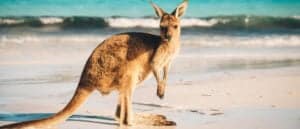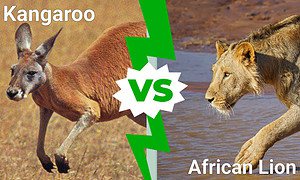Kangaroos are one of the most identifiable creatures on earth. Roos, as they’re lovingly referred to in Australia, are large, furry marsupials with powerful legs and massive tails. There are currently four kangaroo species on earth, and they are all endemic to Australia.
Although kangaroos are in the same family as wallabies and wallaroos, their overall size puts them into unique genera and species. Wallabies are generally small, wallaroos are mid-sized, and kangaroos are big. Tree kangaroos, the only macropods that live in trees, are not generally considered part of the four accepted kangaroo species despite some notable similarities. Below, we list the four recognized species of kangaroos in order from smallest to largest. Here’s a preview in pictures:

Like many animals, kangaroos are sexually dimorphic, meaning the males and females differ in size. For kangaroos, the males are generally bigger than the females. When looking at the stats below, keep in mind that the measurements listed are for the males since they are the bigger members of each species.
4. Antilopine Kangaroo (Osphranter antilopinus)
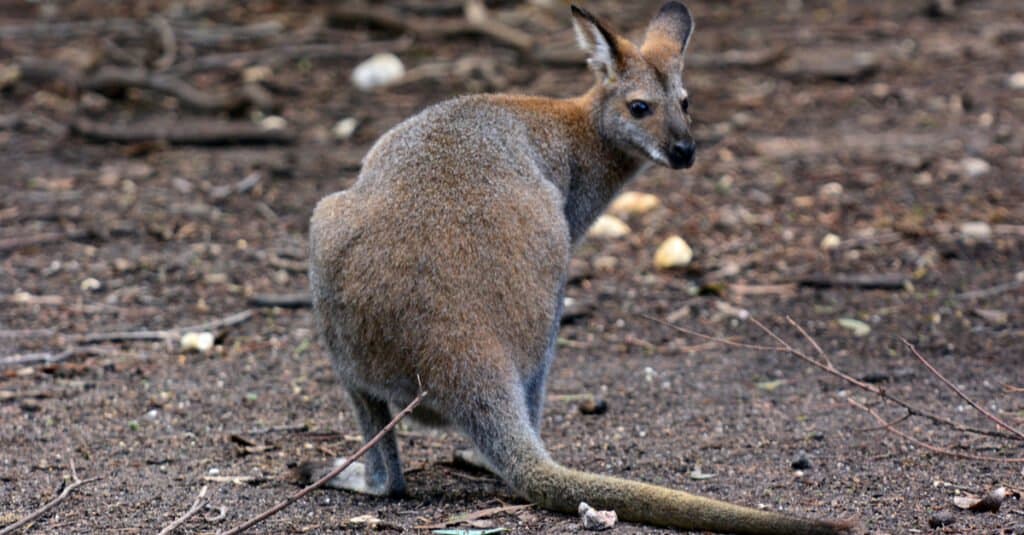
The Antilopine kangaroo is the smallest of the four kangaroo species
©ChameleonsEye/Shutterstock.com
- Avg. body Length: ~3.9 ft. long (1.2 m)
- Avg. tail Length: ~2.95 ft. long (0.9 m)
- Avg. Height: ~3.6 ft. tall (1.1 m)
- Avg. weight: 85-108 lbs.
The Antilopine kangaroo is the smallest of the four kangaroo species and is sometimes referred to as the Antilopine wallaroo. The Antilopine lives along the northern coast of Australia from the Cape York peninsula to the Kimberly region. Coloration varies but generally consists of an overall gray with a reddish tan color covering the back and parts of the head. The underbelly is usually a cream color. A social grazer, the Antilopine usually belongs to a group of kangaroos where males try to assert dominance over one another. Like all roos, the Antilopine has a muscular tail, powerful legs, large feet, a small head with large ears, and a pouch for their young. Infants are called joeys. The Antilopene kangaroo is locally abundant, and the population is assumed to be stable.
3. Western Grey Kangaroo (Macropus fuliginosus)

A Western grey kangaroo in the Australian bush.
©iStock.com/Lea Scaddan
- Avg. body Length: ~2.75-3.6 ft. long (0.84-1.1 m)
- Avg. tail Length: ~2.6-3.3 ft. long (0.8-1 m)
- Avg. Height: ~4.26 ft. tall (1.3 m)
- Avg. weight: 62-120 lbs.
This common marsupial lives along large portions of the southern coast of Australia from Perth to the border with Victoria. A small part of its range overlaps with the larger eastern grey kangaroo, but the two species never interbreed in the wild. There are two subspecies, with the smaller Kangaroo Island subspecies only occurring on Kangaroo Island, roughly seventy miles southwest of Adelaide.
The western grey has a grey to brown coat, with paler shades around the chest, belly, and front of the neck. It is often difficult to tell them apart from the eastern grey, but the westerns generally have darker grey-brown fur and occasionally have a patch of black around the elbow. The subspecies on Kangaroo Island are also known as “sooty” kangaroos due to darker fur around the nose and face. One of the more interesting nicknames for the species is stinker, given because adult male eastern greys give off a curry-like smell.
2. Eastern Grey Kangaroo (Macropus giganteus)
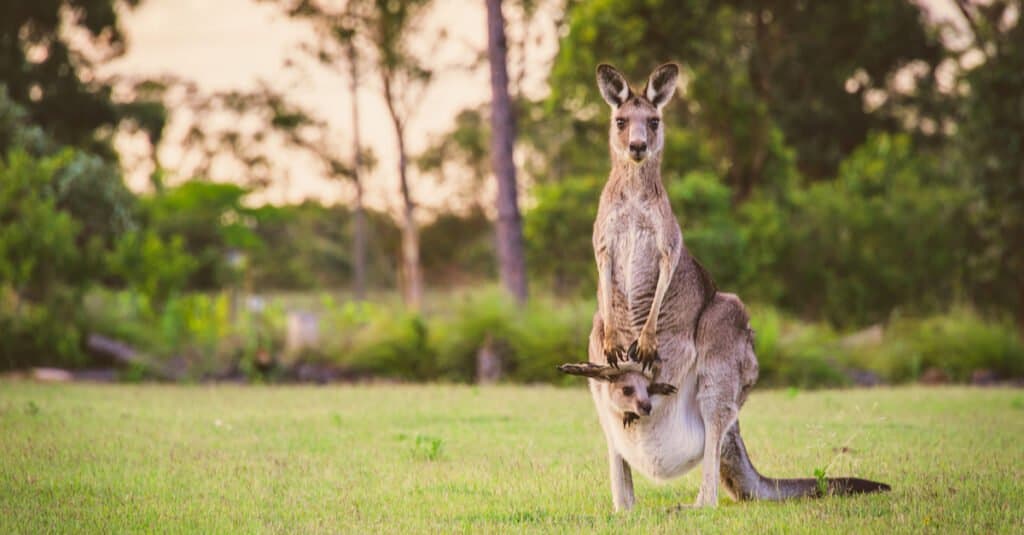
The Eastern Grey is a large marsupial and the most commonly sighted kangaroo because its natural habitat range extends close to major Australian cities.
©IntoTheWorld/Shutterstock.com
- Avg. body Length: ~4.26 ft. long (1.3 m)
- Avg. tail Length: ~3.3 ft. long (1 m)
- Avg. height: ~4.9 ft. tall (1.5 m)
- Avg. weight: 110-146 lbs.
The second-largest kangaroo species, eastern greys are found in the eastern third of Australia and are quite abundant. There’s also a population on the island of Tasmania. The habitat range overlaps with the red kangaroo, but the two species are easy to differentiate, with the eastern grey sporting soft grey fur. Eastern grey kangaroos also prefer generally wetter climates than the red. Like all kangaroos, the eastern grey is crepuscular, meaning it is most active during the twilight hours. During the heat of the day, the eastern greys usually take a siesta, resting under the cover of vegetation until the temperature becomes more manageable. A female eastern grey set the record for fasted kangaroo ever recorded, reaching a speed of 40 miles per hour.
1. Red Kangaroo (Osphranter rufus)
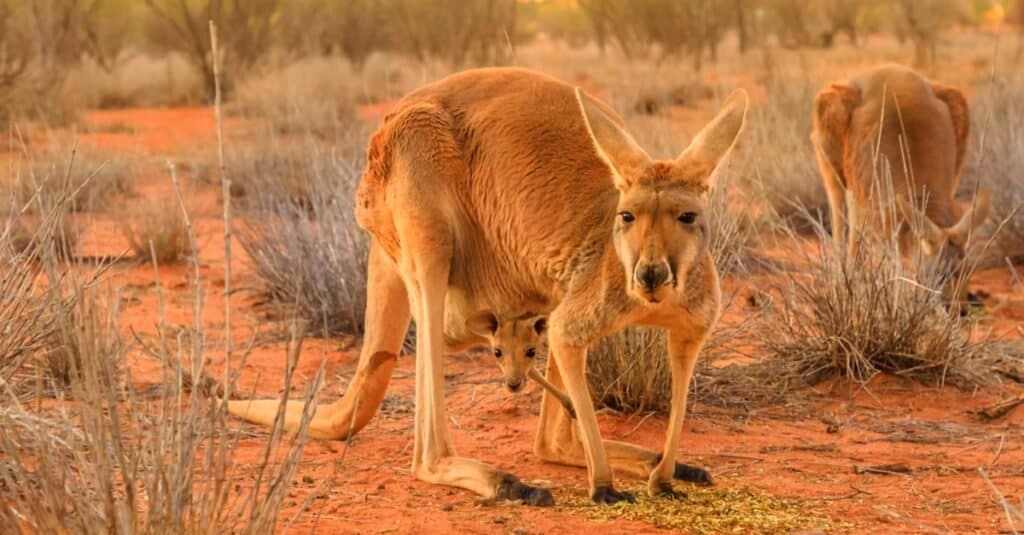
A female Red Kangaroo, with a joey in a pocket, on the red sand of outback central Australia.
©Benny Marty/Shutterstock.com
- Avg. body Length: Up to ~5.25 ft. long (1.6 m)
- Avg. tail Length: ~3.9 ft. long (1.2 m)
- Avg. height: ~5.9 ft. tall (1.8 m)
- Avg. weight: 121-198 lbs.
The red kangaroo is the largest kangaroo species on earth; it is also the national animal of Australia. The range of the red kangaroo is expansive; it can be found in most of the continent’s interior and along some of the northwestern coast. Compared to the eastern grey, the red prefers more arid climates with scrubland, grasses, and the occasional tree grove to shelter under. Red Kangaroos are also a highly adaptive species, adjusting well to human presence and sometimes eating into farmers’ fields.
Red kangaroos are powerful creatures with well-defined and muscular arms and legs capable of leaping feet into the air. Like other kangaroos, males engage in fighting and boxing, using their arms and legs to kick and push their opponents off balance. When delivering a kick, the red can use its tail as a stabilizing appendage on the ground. Males usually only fight over females and to establish superiority in their social groups. The reds that lose fights live alone and avoid other groups.
The Biggest Kangaroo Ever Recorded
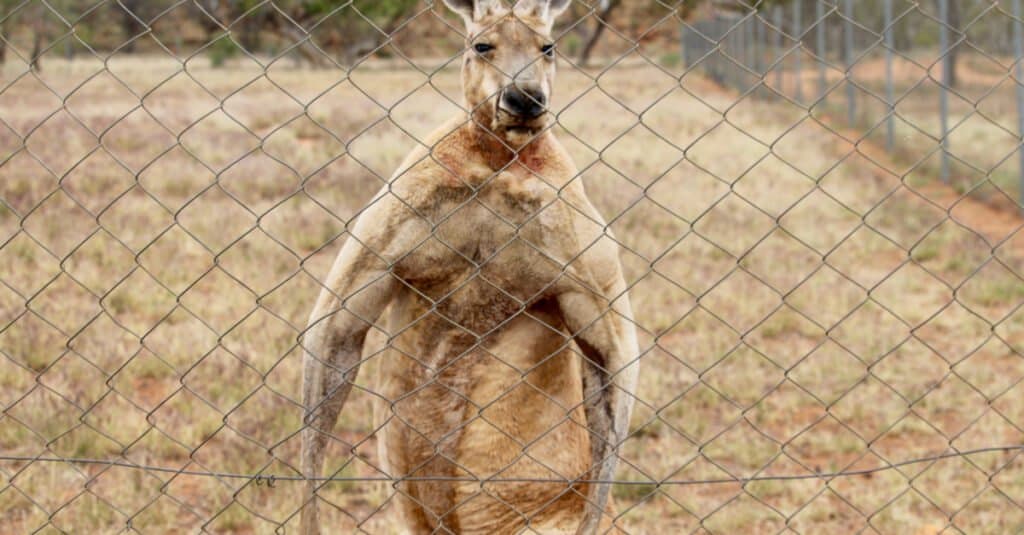
Red kangaroos can sport impressive physiques that look like body builders!
©A Life Beneath Stars/Shutterstock.com
History has something to add about the largest kangaroo species. Although now extinct, the Procoptodon was a genus of enormous kangaroos living in Australia. Using fossil evidence, scientists think they stood up to 6.6 ft. tall and weighed anywhere from 400-530 lbs.
According to the Guinness book of world records, the largest living marsupial recorded was a red kangaroo. The world record was secured in 2017 for a male with an eight-foot length and a standing height of nearly six feet (5’11”). Roger the buff kangaroo, named for his body-builder physique was also a massive kangaroo, weighing over 200 lbs!
Summary of the 4 Largest Kangaroo Species:
| Rank by Size | Name of Kangaroo | Body Length | Tail Length | Height | Weight |
|---|---|---|---|---|---|
| 1. | Red | Up to 5.25 ft. (1.6 m) | 3.9 ft. (1.2 m) | 5.9 ft. (1.8 m) | 121-190 lbs. |
| 2. | Eastern Grey | 4.26 ft. (1.3 m) | 3.3 ft. (1 m) | 4.9 ft. (1.5 m) | 110-146 lbs. |
| 3. | Western Grey | 2.75-3.6 ft. (0.84-1.1 m) | 2.6-3.3 ft (0.8-1 m) | 4.26 ft, (1.3 m) | 62-120 lbs. |
| 4. | Antilopine | 3.9 ft. (1.2 m) | 2.95 ft. (1.1 m) | 3.6 ft. (1.1 m) | 85-108 lbs. |
The photo featured at the top of this post is © A Life Beneath Stars/Shutterstock.com
Thank you for reading! Have some feedback for us? Contact the AZ Animals editorial team.





